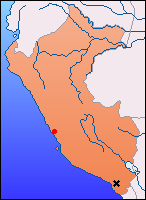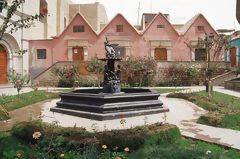 |
Related pages: |
 Moquegua, formerly known as Santa Catalina de Guadalcazar, is located in the largest part of the valley. Seen from above, the city offers a beautiful panorama, surrounded by an impressive volcanic landscape. The majestic Huaynaputina and Tixani volcanoes dominate the region. This quiet city, with its charming colonial streets and buildings, is a true gem of southern Peru.
Moquegua, formerly known as Santa Catalina de Guadalcazar, is located in the largest part of the valley. Seen from above, the city offers a beautiful panorama, surrounded by an impressive volcanic landscape. The majestic Huaynaputina and Tixani volcanoes dominate the region. This quiet city, with its charming colonial streets and buildings, is a true gem of southern Peru.
Historical and archaeological research shows that Moquegua has always been closely linked to the high plateau of Lake Titicaca. From the Early and Middle Horizon periods, the Pucara and Tiahuanaco cultures left their mark on the region. Later, the Colla and Lupaca ethnic groups, late cultures from the Lake Titicaca region, also played a significant role in Moquegua's history. The city's rich pre-Columbian past is still reflected in its traditions and architecture today.
With its colonial buildings and picturesque streets, Moquegua feels as though it has been frozen in time. The city adopted its current name toward the end of the Spanish viceroyalty. Every year on November 25, the people of Moquegua celebrate the Spanish founding of the city and honor Saint Catherine. This celebration highlights the city's rich colonial and cultural heritage, making it an important event for the local community.
Agriculture has long been the main activity in Moquegua, especially the cultivation of fruit trees. However, it is the region's viticulture that has gained fame. Moquegua's wines and macerados became famous and were exported to neighboring countries such as Chile, Bolivia, and Argentina. Today, the production of wine remains a source of pride, and visitors can taste these local wines in several bodegas across the city.
Besides its agricultural past, Moquegua is now known for its rich mineral resources. The mining of copper, iron, and other minerals has become one of the region's main economic activities. This shift toward a mining-based economy has transformed Moquegua into an industrial hub, while the city continues to preserve its cultural heritage and natural beauty.
Moquegua is a unique city that blends a rich historical heritage with modern economic development. Its spectacular volcanic landscapes, historical ties to Lake Titicaca, and viticultural traditions make it a must-visit destination for travelers looking to discover another side of Peru. Whether you're a history enthusiast, wine lover, or simply seeking a stunning natural setting, Moquegua will charm you.